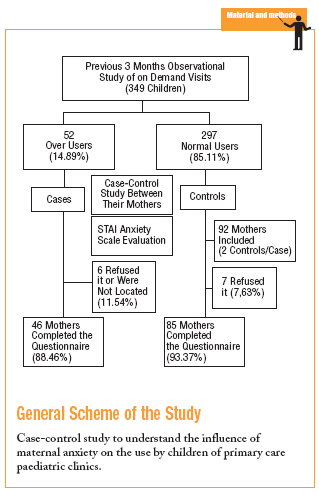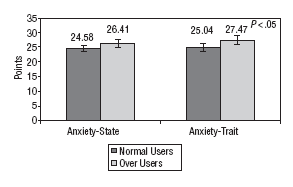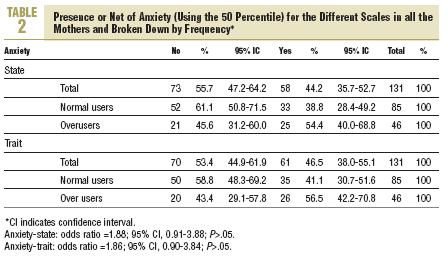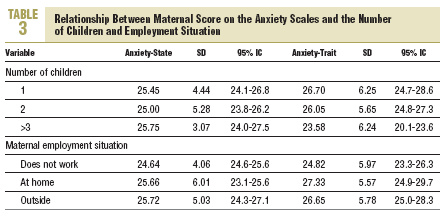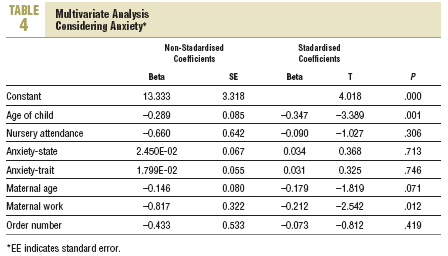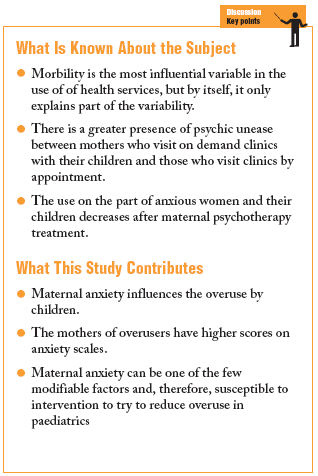Introduction
In primary care, if paediatric age is considered along with the elderly population, a small percentage of patients generate a large part of the visits.
Morbility is the variable which most influences the use of the health services, but at the same time only explains part of this variability.1-4 Some other factors which influence overuse have been identified, but it is not exactly understood how and to what degree they affect the use,3,5 and neither has it been possible to identify them all.2,4,6-8
Some characteristics of these individual have been associated with the level of demand.5,7,9-11 Family changes and psychic discomfort cause a greater use of health services in adults and psychological differences have been implicated as one of the reasons which could explain the different use of services.12,13 Despite these patterns of use for adults, they cannot be valid for infants. On investigating the frequency in paediatrics, the psychological variables of the parents are increasingly being taken into consideration, since children are not capable of deciding when to visit clinics.
Family factors have been associated with the level of demand and a correlation has been established between the use by each member and the family as a whole.2,14-17 Personality disorders have been associated with a higher frequency in adults and it has been reported that people at risk of having any disorder normally use many health resources and they are also shown to be less satisfied with the attention received in primary care.18
The mothers have been the focus of many investigations, which have looked at the determining factors in this use. The perception that they have a degree of vulnerability when faced with illness has been a predictor of the use of paediatric services.19 Maternal abuse of health services has been associated with overuse in paediatrics. The maternal beliefs and perceptions on health can be determining factors in influencing the subsequent use of services on the part of the children when they reach adult age.12,20
Given that, of the known variables, the attitude of the mothers can be one of the few factors susceptible to intervention and change to reduce the overuse of paediatric services,2,10 the present study was designed with the objective of determining the influence of maternal anxiety on the frequency of visits of the children in primary care paediatric clinics in our health area.
Patients and Methods
Scope
Teaching health centres of Area 17 of the Community of Valencia (Acacias, Novelda, and Petrer 1). In each of them a paediatrician has participated with quotas of 908, 1117, and 981 children, respectively (3006 in total).
Design
After having carried out a multicentre longitudinal prospective observational study for 3 months, in which over user children between 0 and 14 years were selected, a case control study was carried out between the mothers to evaluate the possible influence of maternal anxiety on the high frequency of visits by the children.
To define high frequency different valid approaches are available. In the few studies carried out in paediatrics, the most common choice was the mean number of on demand clinic visits in a period, plus one standard deviation (SD),14,21 which was adopted by our study. Other possibilities are the use of percentiles of the number of visits per year, the mean of visits plus 2 SD22 or arbitrary parameters of the number of visits.23
To evaluate anxiety, the Spanish (IDARE)24 version of the STAI (State-Trait Anxiety Inventory) questionnaire was used, which contains separate self-evaluation scales to measure independent concepts of anxiety. Each scale has 20 items and each one of these has a range of 0 to 3 points. The anxiety state (AS) is defined as a transitory emotional state or condition which is susceptible to variation with time and fluctuates in intensity. Anxiety trait (AT) points to an anxiety tendency, relative stable, in which the subjects differ in their tendency to perceive situations such as threatening ones, and as a result increase their (AS). Both are considered positive when they exceed the 50 percentile.
Patient Selection
After identifying the children with a higher level of visits in a prospective observational study, a case control study was carried out on the mothers, defining as cases the mothers of over users and a group of mothers who voluntarily accepted, pertaining to the study and with similar characteristics, except the fact that their children had a normal level of visits.
To increase the power of the sample, to have 2 homogeneous groups in the comparison and to minimise the selection bias, it was decided to study 2 controls for each case.
Results
Of the total of over users (52 of 349 studied, 14.89% of the sample), 46 mothers (88.46%) completed the questionnaire, since 6 were not located, or rejected for various reasons. Of the 92 mothers of normal users, 85 (92.37%) of those proposed, completed it.
As regards the total population surveyed (n=131), the scores obtained by the mothers on the anxiety scales, for both AS and AT, are shown in Table 1.
When the scale scores are examined, AS as well as AR, in relation to the frequency level, significant differences are obtained, which are higher in the mothers of over users (P=.036 and P=.023, respectively) (Figure).
Fig. 1. Maternal score on the anxiety scales for the different groups of user.
According to the definition in the scales manual,24 it is considered that a person has anxiety when the values exceed the 50 percentile. According to our results, this means more than 25 points for AS and more than 26 for AT. Using this criteria, 44.27 and 46.27%, respectively, of the total number of mothers surveyed are considered to have a high anxiety level. If, instead of evaluating the variable in quantitative form (global scores of the scales), establishing 2 categories for mothers (with or without anxiety), and relate them to the frequency, the data in Table 2 is obtained. In both cases differences between groups are obtained, but without statistical significance (P=.088 and P=.093).
The results of the relationship of the number of children in families and the maternal employment situation with the scores obtained on the anxiety scales (no statistical differences) are shown in Table 3.
In the observational study on overuse, a multivariate analysis was carried out, with the visits on demand as dependent variable and, as independent variables those which had been shown as predictors of increased use (age of child, nursery attendance, maternal age, mother's employment and order number as regards his/her brothers and sisters). The explained variability for the model was 0.149.
On repeating the multivariate analysis, adding the AS and AT to the previous variables gave the results shown in Table 4. The differences continued to be significant only for age of child and maternal employment. The significant analysis was still .000. The explained variability is higher than before and rises to 0.227.
Discussion
In studies carried out on mothers, an increased presence of psychic discomfort has been reported between those who turn up at on demand clinics, more than in those who visit by appointment.25 The lower tolerance of anxious women and the negative perceptions about their children, together with dysfunctional behaviour or somatization which sometimes arises in children and the perception of emotional problems in their mothers, can increase attendance at clinics.26
Some authors have analysed the personalities of the mothers of over users27 and have suggested that the incapacity which particular personal profiles have in making daily decisions without an exaggerated amount of advice or recommendations could be associated with higher use. Our results, with higher score in the mothers of over users, taking into consideration the AS as well as the AR, are similar to those from other studies.14,19,25,28,29
The fact that almost half the total of the mothers surveyed could be said to have anxiety, on their scores exceeding the 50 percentile, in principle is striking, but it also coincides with that described by other authors, who found similar figures.25,27
The presence of differences in the scores on the scales of the mothers of normal users and over users, along with the lack of significance on establishing 2 groups of mothers (with and without anxiety), we consider that it could be due to the power of the study since, possibly, an increase in this might have resulted in a greater significance and a better explanation of the model.
Results similar to ours have been reported in respect to the number of children per family and the maternal employment situation,12,25 but it is known that an unstable work situation can be a risk factor in presenting with anxiety disorders5 and on occasions, has been found to be significant.14,30
In conclusion, we highlight that anxiety is a modifiable factor, and therefore potentially reducible, which should be taken into account on analysing overuse in paediatrics. As regards to this, there are studies in which the use by anxious mothers and their children for 3 years before and after psychotherapy of the former has been measured, and the decrease in use by both has been demonstrated after intervention.31







